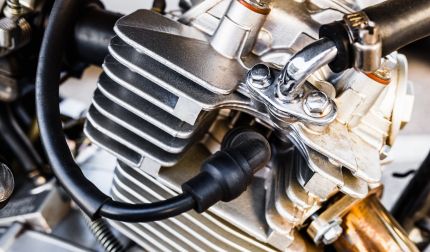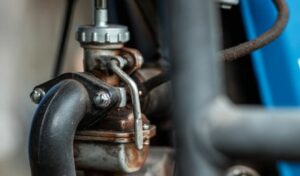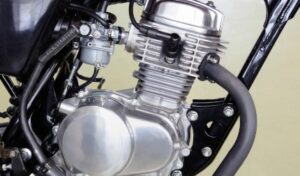Spark plugs power motorcycles and other combustible engines. These tiny but vital parts are essential to engine performance. Motorcycle owners must learn to recognise spark plug problems. This knowledge protects the engine and motorcycle.
Motorcycle spark plugs are its heart. The combustion chamber’s fuel-air mixture explodes, propelling the pistons. This thousands-per-minute process powers the motorbike.
A running engine requires spark plugs. Poor spark plugs may misfire or spark at the wrong time, affecting engine performance, fuel economy, and even engine damage.
How Spark Plugs Function in a Motorcycle
Motorcycles need spark plugs. Understanding how spark plugs work in the engine helps explain the problems they can cause.
Combustion in a motorcycle engine turns fuel into motion. Air and fuel enter the combustion chamber through the intake valve. The piston then compresses this mixture.
The spark plug ignites the compressed air-fuel mixture. The explosion drops the piston, turning the crankshaft and propelling the motorcycle. The exhaust valve releases combustion gases, restarting the cycle.
Spark plugs are crucial. They spark the air-fuel mixture at the top of the combustion chamber. This spark must be timed correctly in the combustion cycle to maximise explosion power and prevent engine damage.
Spark plugs must also resist fuel residue and high temperatures. They must also maintain a precise spark gap to ignite the fuel-air mixture.
Types of Spark Plugs and Their Characteristics
There are several types of spark plugs, each with unique characteristics:
- Copper Spark Plugs: These are standard spark plugs. They have good conductivity but a shorter lifespan than others.
- Iridium Spark Plugs: Iridium plugs cost more but last longer and spark stronger than copper.
- Platinum Spark Plugs: Platinum plugs last longer than copper, resist corrosion, and spark consistently. Copper and iridium are more conductive.
- Double Platinum Spark Plugs: These outperform single platinum plugs and last longer.
- Laser Iridium Spark Plugs: These plugs have the best performance and lifespan but cost more.
Your motorcycle’s make, model, and engine specs determine its spark plug. Spark plug maintenance and replacement can prevent most spark plug issues and improve ride quality.
7 Symptoms of Bad Spark Plugs on A Motorcycle
Motorcycle owners must recognise failing spark plugs to avoid engine damage and optimise performance. Common motorcycle spark plug symptoms include:
If you see any of these signs, replace your spark plugs. If in doubt, ask a mechanic. Maintaining and replacing your motorcycle’s spark plugs can prevent many of these issues, ensuring smooth rides and engine longevity.
1. Difficulty Starting
Starting the motorcycle can be a sign of bad spark plugs. Motorcycle spark plugs ignite the combustion chamber’s air-fuel mixture. Combustion starts and runs the engine.
If the spark plugs are faulty, worn out, or fouled, they may not spark or spark too weakly to ignite the fuel. This may prevent the engine from starting or require multiple attempts.
Motorcycles may not start in extreme cases. Bad spark plugs are one of the most common causes of starting problems.
Check your spark plugs if your bike won’t start. Check for wear, damage, and deposits. Replacing the spark plugs may fix the issue. If in doubt, ask a mechanic.
2. Poor Acceleration
Another sign of failing spark plugs is poor acceleration or throttle response. Spark plugs ignite the combustion chamber air-fuel mixture at the right time. Correct ignition produces smooth, powerful acceleration.
However, worn or damaged spark plugs may not produce a strong or timely spark to ignite the fuel. This can delay engine acceleration. The motorcycle may seem to struggle to gain speed or respond slowly or weakly. It’s called “hesitation.”
Your motorcycle’s performance may decrease, especially at high speeds or steep inclines. These situations require more engine power, and if the spark plugs aren’t working properly, they can’t provide the spark.
If your motorcycle’s acceleration or performance changes significantly, check your spark plugs. Replacing bad spark plugs often restores motorcycle power and acceleration. If in doubt, consult a professional.
3. Decreased Fuel Efficiency
Faulty spark plugs can cause your motorcycle’s fuel efficiency to drop significantly. Spark plugs ignite the engine’s air-fuel mixture. The engine should burn as much fuel as possible during this combustion process.
However, worn, dirty, or damaged spark plugs may not generate a strong or timely spark to ignite the fuel. Inefficient combustion wastes some fuel. Wasted fuel passes through the engine and out the exhaust without powering the motorcycle, decreasing fuel efficiency.
Even though your riding habits haven’t changed, you may find that you’re getting fewer miles per gallon or filling up more often. In these cases, check your spark plugs. Replacing dirty or worn ones may improve your motorcycle’s fuel efficiency.
However, decreased fuel efficiency can also indicate engine issues or riding style changes. If replacing the spark plugs doesn’t improve fuel efficiency, you may need a professional mechanic to check the engine.
4. Engine Misfires or Surges
Motorcycle misfires or surges may indicate bad spark plugs. The combustion chamber misfires when the spark plugs fail to ignite the fuel-air mixture at the right time. Stuttering or “missing” power strokes can result from this power delivery interruption.
Symptoms of engine misfires vary. The engine may stutter or jolt during acceleration. The motorcycle may briefly lose power.
The engine surges when it delivers more power than expected. This uneven power delivery can make the ride jerky.
Spark plugs cause engine misfires and surges. The spark can’t ignite the air-fuel mixture efficiently if it’s weak or late. Checking and replacing spark plugs may fix this.
Misfires and surges may also be caused by other engine issues. If the problem persists after replacing the spark plugs, take your motorcycle to a professional mechanic for a thorough checkup.
5. Rough Idle:
Another sign of faulty spark plugs in a motorcycle is a rough idle. The engine runs at a very low power level when your motorcycle is idling. This should be smooth and consistent, with the engine maintaining a steady rhythm.
The spark plugs may not be able to maintain this smooth, consistent spark if they are failing. They could misfire or spark instead. Idling may be rough or uneven due to this. The engine may sound different, popping, rattling, or revving irregularly. Additionally, the motorcycle may vibrate more.
If the idle speed is too uneven, the engine may not get enough power and the motorcycle may stall. When your motorcycle is idling, check your spark plugs if you see any of these signs. Replacing them may fix the problem if they’re dirty, worn out, or damaged.
However, fuel system or air intake issues can also cause a rough idle. Consult a mechanic if replacing the spark plugs doesn’t fix the idle.
6. Increased Exhaust Emissions:
Motorcycle spark plug failure can cause increased exhaust emissions. Spark plugs efficiently ignite the fuel-air mixture in the engine’s combustion chamber, converting most of the fuel into energy.
Bad spark plugs may not ignite fuel-air mixtures. Inefficiency can cause more unburned fuel to exit the engine and exit the exhaust system. Unburned fuel increases emissions and exhaust changes.
Motorcycle exhaust smoke may change colour or volume. Black or blue smoke indicates unburned fuel being expelled as exhaust gases. Exhaust smoke harms the environment and reduces fuel efficiency and engine performance.
Fuel or exhaust system issues can also increase exhaust emissions. If you see excessive or unusually coloured exhaust smoke, have your motorcycle inspected immediately. Replacing spark plugs should fix the issue. If the problem persists, engine and exhaust system inspections may be needed.
7. Engine Stalling or Hesitation
Bad spark plugs can cause engine stalling or hesitation. When spark plugs fail to spark, combustion is inefficient or interrupted, causing these symptoms.
During operation, the engine stalls. When spark plugs don’t spark consistently, combustion stops and the engine shuts down. When idling or moving slowly, stalling is most noticeable. Stalling is annoying and dangerous, especially in heavy traffic.
However, engine hesitation is a delay in acceleration. Spark plugs fail to ignite the air-fuel mixture during acceleration. When you twist the throttle, the motorcycle may hesitate or struggle to accelerate.
Spark plugs can cause stalling and hesitation. If these problems persist, check your spark plugs for wear, damage, or dirt. Replace the spark plugs.
However, other engine issues may cause stalling and hesitation. If these issues persist after replacing the spark plugs, have a motorcycle mechanic inspect it.
Identifying Common Symptoms
Examining Spark Plug Condition
Motorcycle engines need regular spark plug checks. Remove the engine’s spark plugs with a socket. After removal, look for these signs of wear:
- Check the ceramic spark plug insulator for cracks or chips. Check threads and metal shell for corrosion or stripping.
- Look for melting, wear, or breakage on the spark plug’s central and ground electrodes.
Understanding Spark Plug Colors and Deposits
A spark plug’s colour can indicate engine health. Colors and meanings:
- Normal: A healthy spark plug is light tan or grey. The engine’s air-fuel mixture and spark plug temperature are correct.
- Black and Sooty: Rich conditions indicate too much fuel and not enough air. Deposits on the spark plug can cause fouling.
- White or Light Gray: This could indicate a lean condition with too much air and not enough fuel. This can overheat the engine and spark plug.
Interpreting Electrode Wear Patterns
Spark plug electrodes reveal engine health:
Normal Wear: After many miles, some wear is normal. Normal operation indicates even wear and no rounded or eroded electrodes.
Excessive Wear or Erosion: A worn spark plug may need to be replaced. It may indicate engine issues like detonation.
Deposits: Oil leaks into the combustion chamber or fuel issues can cause electrode deposits.
Performing Compression and Leak-down Tests
Compression and leak-down tests are more advanced diagnostic tests that can reveal engine health:
The compression stroke’s piston pressure is measured in a compression test. Valve, head gasket, or piston ring issues can cause low cylinder compression.
Leak-down tests assess cylinder sealing. This test pressurises the cylinders with compressed air and measures air leakage. Engine problems can cause excessive leakage.
Due to their complexity, professional mechanics should perform these tests. If you’re unsure about your spark plugs or engine, consult a professional.
Other Causes of Spark Plug Problems
Normal Wear and Tear
Motorcycle use naturally wears spark plugs. Repeatedly igniting the fuel-air mixture in the combustion chamber wears down the spark plug electrodes. Thus, the spark plugs may not produce a strong or consistent spark to ignite the fuel. Spark plug replacement should be part of your motorcycle’s regular maintenance schedule.
Improper Spark Plug Heat Range
Each engine requires spark plugs with a specific heat range to dissipate combustion chamber heat. Mismatching spark plug heat ranges can cause engine issues. Hot spark plugs can pre-ignite and damage engines. Too much cold can cause spark plug fouling.
Poor Fuel Quality or Wrong Fuel Mixture
Fuel quality and fuel-air mixture can damage spark plugs. Rich mixtures cause spark plug soot. Lean mixtures overheat spark plugs and engines. Fuel with too many additives or contaminants can also deposit spark plugs.
Oil or Coolant Leaks
If oil or coolant leaks into the combustion chamber, it can cause fouling of the spark plugs. This is often a sign of a more serious engine problem, such as a faulty head gasket or worn piston rings.
Incorrect Ignition Timing
The ignition timing can cause the spark plugs to spark incorrectly. This can cause engine damage, poor performance, and higher emissions.
Maintaining your engine and spark plugs prevents most issues. Consult a professional mechanic if you suspect spark plug trouble. They can diagnose and fix the issue, keeping your motorbike running smoothly.
Maintenance and Replacement
Regular Inspection and Cleaning
Motorcycle maintenance requires spark plug inspections. Spark plugs should be checked every few thousand miles, depending on motorcycle use. Check electrodes for physical damage, deposits, or wear. Wire brushes and cleaning solutions can clean dirty spark plugs. Cleaning spark plugs is only a temporary fix, so replace worn or damaged ones.
Correct Spark Plug Installation
Engine performance depends on spark plug installation. Check the spark plug gap (ground-to-center electrode distance) when installing a spark plug. For optimal performance, your motorcycle’s manufacturer recommends setting the gap.
To ensure a good seal without damaging the spark plug or cylinder head, spark plugs should be tightened to the correct torque. Use a torque wrench. Finally, the spark plug wires or ignition coils should be securely connected to avoid disconnection or vibration while the engine is running.
Choosing the Right Spark Plug
Use motorcycle-compatible spark plugs. Find the right spark plug for your motorcycle by consulting the manual or a professional mechanic. Consider spark plug material, heat range, size, and design. It optimise combustion, fuel efficiency, and engine performance.
Spark Plug Replacement Interval
Spark plug replacement intervals depend on your motorcycle’s spark plug type, usage, and maintenance schedule. Traditional copper spark plugs should be replaced every 10,000 to 20,000 miles, while platinum or iridium can last 60,000 to 80,000 miles. For optimal motorcycle maintenance, follow your manufacturer’s instructions.
Maintaining and replacing bad spark plugs will keep your motorcycle engine running smoothly, efficiently, and long. Consult a professional if you’re unsure about spark plug maintenance or replacement.
Frequently Asked Questions (FAQs)
1. What are the signs of worn-out spark plugs?
Signs of worn spark plugs include. These include difficulty starting your motorcycle, poor acceleration, decreased fuel efficiency, engine misfires or surges, rough idle, increased exhaust emissions, and engine stalling or hesitation. If you’re having these issues, check your spark plugs.
2. How often should I replace my motorcycle’s spark plugs?
Spark plug replacement frequency depends on several factors. These include your motorcycle’s maintenance schedule, spark plug type, and use. Platinum or iridium spark plugs last 60,000 to 80,000 miles, while copper spark plugs last 10,000 to 20,000 miles. Check your motorcycle’s owner’s manual for specific instructions.
3. Can bad spark plugs damage my motorcycle’s engine?
Spark plugs can damage your motorcycle’s engine. The engine may overheat or pre-ignite if the spark plugs don’t properly ignite the fuel-air mixture. If ignored, these can damage engines. Spark plug inspection and maintenance can prevent these issues.
4. What causes spark plugs to foul?
Many factors can foul spark plugs. These include running a rich fuel-air mixture (too much fuel), using low-quality fuel, oil or coolant leaks into the combustion chamber, and spark plugs with the wrong heat range for your engine. Engine performance can suffer from fouled spark plugs.
5. Can I clean and reuse fouled spark plugs?
Clean and reuse fouled spark plugs. Remove the spark plugs and use a wire brush and cleaning solution to remove deposits. This is a temporary fix. If spark plugs are fouled due to a rich fuel-air mixture or oil leak, the problem will likely return unless the cause is fixed. Also, replace worn spark plugs.
Conclusion
Motorcycle performance and maintenance depend on spark plugs. These tiny but vital components ignite the fuel-air mixture in the engine’s combustion chamber, powering your motorcycle.
Faulty or worn spark plugs can cause engine stalling, hesitation, engine misfires or surges, a rough idle, increased exhaust emissions, and difficulty starting. Regular inspection, cleaning, and replacement of these components prevent engine damage and ensure smooth operation.
Your motorcycle’s engine will last longer if you use the manufacturer’s recommended spark plug and install it properly. Knowing spark plug causes can aid engine diagnosis and repair.
Finally, motorcycle spark plug maintenance is crucial. This improves performance and engine life. Always consult a mechanic when in doubt. Their knowledge can help you maintain your motorbike.






